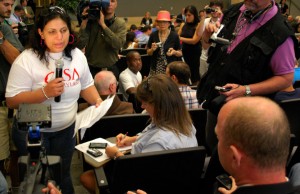ARLINGTON, VA. —Immigration activists flooded into a public hearing and confronted an Immigration and Customs Enforcement official in this Washington, D.C. suburb Wednesday to protest a program they say is heavy-handed and a threat to public safety.
About 400 hundred opponents of the Secure Communities Program, which uses state and local law enforcement biometric databases to identify illegal immigrants, demonstrated outside the George Mason Law Center, where the hearing was held, before filling auditorium seats inside.

Maria Bolaños confronts Marc Rapp, an Immigration and Customs Enforcement official, at a hearing about the controversial Secure Communities program Wednesday night. Bolaños may be deported after calling 911 for help during a domestic dispute. (Gillian Brockell/MNS)
This is the last stop on a national tour for a non-governmental task force appointed to evaluate the program and recommend changes. Previous hearings in Los Angeles, Dallas and Chicago were also met with large demonstrations.
Activists from Casa de Maryland, an advocacy group for immigrants from Central America, interrupted the public testimony period to bring out two women who are in deportation proceedings to speak to Marc Rapp, the ICE acting assistant director for the Secure Communities Program, who sat in the audience.
Hearing organizers attempted to ignore the scene and called on the next members of the public listed to speak, all of whom said they wished to donate their time to the women. The organizers eventually relented.
“Mr. Rapp, I am not a criminal,” Maria Bolaños said through an interpreter.
Bolaños may be deported. She called police during a domestic dispute last Christmas. While on the scene, police officers arrested her for illegally selling a telephone card to a neighbor, a charge that was later dropped. Bolaños said she is afraid to leave her 2-year-old daughter, who is a U.S. citizen.
“I hope you understand, Mr. Rapp,” she said. “Maybe you are a parent, too.”
Rapp did not respond to the women and declined to comment.
The program’s advocates say using identification data like fingerprints that have already been gathered by state and local jurisdictions helps ICE identify, prioritize and remove criminal aliens who pose a threat to public safety.
Since the program began in October 2008, more than 277,000 immigrants have been transferred into ICE custody, and more than 120,000 have been deported.
But 28 percent of those deported under the program were never charged with a crime, according to the agency’s own data. Another 31 percent were convicted of low-level offenses, such as traffic violations.
Marisa Vertrees, of the St. Charles Borromeo Catholic Church in Arlington, said her church is working with a young man who is now in deportation proceedings after being detained for not wearing a seatbelt.
“Is this really who we wish immigration enforcement to be targeting?” she said.
Ira Mehlman, a spokesman for the Federation for American Immigration Reform, said even if an illegal immigrant isn’t prosecuted, they still did something to warrant being fingerprinted.
“There seems to be a sense that only reason someone should be deported is if they committed some heinous crime,” he said. “The job of ICE and DHS isn’t to make people who are violating immigration laws feel entirely comfortable. “
But immigrant and public safety advocates also say the fear of deportation keeps illegal immigrants from reporting crimes, putting them and everyone else in the community in danger.
“Without assurances that contact with the police would not result in purely civil immigration enforcement action, the hard won trust, communication and cooperation from the immigrant community would disappear,” said a representative for the Major Cities Chiefs Association in a statement.
The situation looks a lot different to a cop on the street than it does to the “political brass that run the departments,” Mehlman said. Police officers frequently get information from sources that may not be following the letter of the law without reporting those minor offenses, he said.
“There’s no reason for people to fear that if they pick up the phone to say, ‘This is what I saw,’ they’re going to get deported,” he said.
Opponents of the program claimed that’s exactly what happened to Bolaños,
Shortly after the women’s testimony, members of Casa de Maryland walked out of the auditorium, chanting, “End it, don’t amend it.”
This was the public hearing before the task force makes recommendation to ICE Director John Morton.

